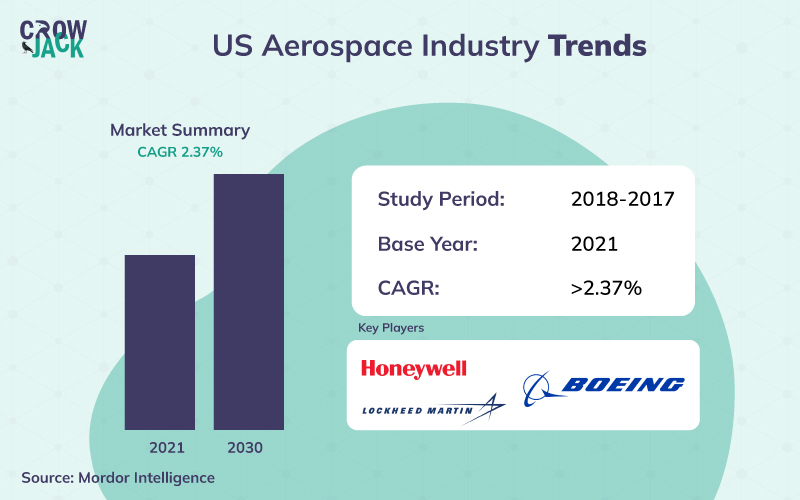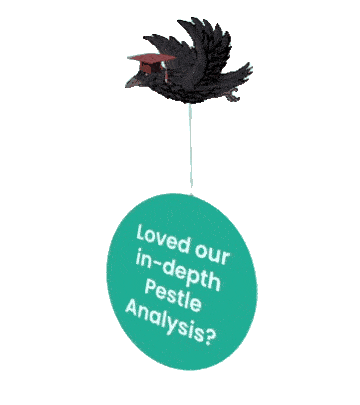Boeing’s Overview
Boeing is a US-based manufacturer of commercial, and military aircraft as well as business jets. It has different products in its portfolio that include Dreamliner, Max 737, and Boeing 747 among others. Boeing has a huge workforce comprising 142,000 employees (Statista, 2022). The company earned a revenue of $62.29 billion in 2021, less than the $101 that it earned during the pre-COVID period in 2018 (Salas, 2022). It has a market capitalization of more than $104 billion.
Companies need to analyze the markets with respect to external factors before venturing into them or further expanding their business. For this, various tools can be helpful and PESTLE analysis is considered the most effective tool as it depicts the overall scenario in the country concerning politics, economics, society, technology as well as legal and environmental aspects. Having said that, this article presents a detailed PESTLE Analysis of Boeing to highlight the impact of external factors on the company’s strategic planning. Moreover, if you wish to learn about PESTLE analysis in detail, you can go through our meticulous PESTLE Analysis guide. As of now, let us get started with the PESTLE analysis of Boeing.
This very analysis would contain the findings of the impacts of the political, economic, social, technological, legal, and environmental scenario in the US concerning the aerospace industry.
Table of Contents
Elaborated and Strategic PESTLE Analysis of Boeing
Political factors affecting Boeing
The federal government of the US has launched Aviation Manufacturing Jobs Protection Program wherein the employers can avail 50% subsidy for the pay and benefits being granted to employees. This would ease the financial burden of the aerospace companies (Internal Association of Mechanists and Aerospace Workers, 2021). Further, aerospace companies are liable to pay federal tax, which currently stands at 21 % (PwC, 2022). It has been reduced from 35% during the last 1 year. The reduction in taxes is positive news for the companies as their financial liabilities would decrease.
In addition, the Russia-Ukraine war could have a financial impact on the business of the companies as all aerospace companies have been banned from operating in Russia, thus hampering their existing sale contracts of 62 planes to different Russian airlines and would also affect the spare parts and service business ( Alarabiya News, 2022).
The aerospace companies that are engaged in the manufacturing of fighter aircraft can cherish the fact that there are many ongoing serious disputes between the nations such as the ongoing war between the Russia and Ukraine along with the tensions in other parts of the world as well such as the Kashmir issue between India and Pakistan. These types of rivalries present a great chance for the aerospace companies to increase their sales as the nations would be needing fighter aircraft to enhance their security.
Economic factors affecting Boeing
As per the numbers quoted by the United Nations, air travel was down by almost 60% in the first year of the COVID and the industry suffered losses amounting to about $370 billion. The demand is not expected to see a sudden rise shortly with borders of many countries still closed and the new COVID variant has emerged after omicron. This would result in a lowering of demand for the planes and hence the aerospace companies could suffer a serious loss because of the situation.
Further, the growth rate of the US for the FY2021 has been 5.7% (US Department of Commerce). It is expected to decline to 4% in 2022 and a further 2% by 2024 and the unemployment rate for FY2021 was 3.9% and is further expected to lower a bit to 3.5% in 2022 and maintain the same levels in 2023 and 2024 (Amadeo, 2022).
The decrease in growth rate and stability in the unemployment rate signifies no positive impact on the real income of the people, thereby leading to a reduction in their purchasing power. This could have an impact on their travel budgets, thus harming the manufacturing and sales of the aerospace industry. The aerospace companies have to source around 30% of their raw materials from different countries like China, Japan, Korea, France, the UK, etc. (Kavilanz, 2013). As the companies are involved in lots of foreign dealings, any fluctuation in exchange rates would significantly impact the cost of the products.
The US aerospace industry is worth $416.63 billion in 2020 and is predicted to grow from $ 416.63 billion to $ 550.78 billion at a CAGR of around 2.37% from 2021-to 2030, thus signifying a stable growth in the industry. Further, with respect to the US aerospace industry, key trends are presented in the infographic below.

Social factors affecting Boeing
Air travel has decreased by 60% due to pandemics, therefore leading to less demand for new aircraft (UN, 2021). The lower demand could impact the profitability of the aerospace industry. Many customers are now getting aware of the concept of sustainability and according to World Economic Forum, the aviation companies would have to shift to sustainable fuel options such as the generation of turbine fuel from the waste cooking oil, agricultural residues, and municipal waste.
For this, the companies would need to invest in research and development that would require high expenditure from the companies’ perspective. Further, around 50% of people prefer paying more to avoid traveling in the Max model of Boeing and 81% of business travelers coupled with 86% of leisure travelers fear traveling in 737 Max because of the continuous accidents and resultant fatalities. This means that aerospace companies highly need to focus on the safety aspect while manufacturing planes in the future.
Technological factors affecting Boeing
The US government spends $16 billion on an average, half of the world’s average for R&D in the aerospace industry (Szmiegra, 2021). Further, many new technologies have emerged in the aerospace industry that includes plane running solely on hydrogen, thereby eliminating carbon emissions. Also, the use of blockchain for managing the supply chain and 3D printing for manufacturing various parts of aircraft is gaining trend along with the use of the Internet of Things for predicting potential damage for example by collecting data from ultrasonic and vibration sensors attached to the spindle of a CNC machine (Profozich, 2021). Companies will have to rely on effective change management models for the successful integration of emerging technologies.
Legal factors affecting Boeing
The Federal Aviation Agency regulates the operations of the aerospace industry in the US. Various laws that have an impact on the operations of the aerospace industry include the Federal Aviation Act for overseeing and regulating safety in the aircraft, various federal aviation regulations such as 14 CFR Parts 21 and 25 that deal with the design and manufacturing of the aircraft while Parts 43 and 145 are rated to maintenance and repair of the aircraft (CaseyGarry, 2022). Further, the businesses are encouraged to innovate and the technologies can be patented for 20 years (USPTO, 2022).
Environmental factors affecting Boeing
The aerospace industry is responsible for about 3.5% of the total carbon emissions in the US. The US is. A signatory to the Paris Accord and therefore has decided to reduce its carbon emissions by 50% till 2030 to adhere to the agreements. The government has rectified its Greenhouse Gas emission standards and has reduced the limit of emissions from an aircraft in line with the International Civil Aviation Organization from 2026 (Ahn, 2021). The aircraft would not be allowed to manufacture if the requirements are not met. This would increase the financial burden on the aerospace companies as they would have to research for manufacturing environment-friendly aircraft.
To conclude, the aerospace industry was one of the major hits industry during the COVID but it is reviving because of various government assistance. Moreover, the political tensions around the world are a perfect chance for the companies to target various government contracts and increase their sales. However. The industry needs to take into account the trend that people are shifting more towards sustainability so they should focus on manufacturing the planes that are capable of running on sustainable fuel options. For long-term viability, it has become essential for companies to address environmental concerns linked to specific industries.
To conclude, the US has cordial trade relations with other nations and military blocks like NATO hence, the aviation and aerospace industry in the country has a great opportunity to drive greater success as countries are looking for greater self-sufficiency in terms of military power and advanced fighter jets. As for the commercial market, there has been a decline in air travel since the advent of the pandemic. Moreover, the industry is under enormous pressure to come up with sustainable alternatives and clean energy options as fossil fuels are diminishing at an alarming pace and governments are showing a greater inclination toward sustainable businesses. Further, to understand in internal capabilities and shortcomings of Boeing, you should definitely read our intelligible SWOT Analysis of Boeing.
Recommended Readings
PESTLE Analysis of Southwest Airlines
References
Ahn, S. (2021). EPA’s New Aviation Emissions Standard: Why It’s Already Obsolete. Retrieved 18 April 2022, from https://eelp.law.harvard.edu/2021/02/epas-aviation-emissions-standard/
Alarabiya News. (2022). Explainer: How headwinds from sanctions on Russia are battering global aviation. Retrieved 18 April 2022, from https://english.alarabiya.net/amp/features/2022/03/08/Explainer-How-headwinds-from-sanctions-on-Russia-are-battering-global-aviation https://english.alarabiya.net/amp/features/2022/03/08/Explainer-How-headwinds-from-sanctions-on-Russia-are-battering-global-aviation
AMADEO, K. (2022). U.S. Economic Outlook for 2022 and Beyond. Retrieved 18 April 2022, from https://www.thebalance.com/us-economic-outlook-3305669
Bureau of Economic Analysis. (2022). Gross Domestic Product, Fourth Quarter and Year 2021 (Advance Estimate). Retrieved 18 April 2022, from https://www.bea.gov/news/2022/gross-domestic-product-fourth-quarter-and-year-2021-advance-estimate
INTERNATIONAL ASSOCIATION OF MACHINISTS AND AEROSPACE WORKERS. (2021). Strong Push by Machinists Union Results in Launching of Aviation Manufacturing Jobs Protection Program. Retrieved 18 April 2022, from https://www.goiam.org/news/strong-push-by-machinists-union-results-in-launching-of-aviation-manufacturing-jobs-protection-program/
Kavilanz, P. (2013). Dreamliner: Where in the world its parts come from. Retrieved 18 April 2022, from https://money.cnn.com/2013/01/18/news/companies/boeing-dreamliner-parts/index.html
SCHAPER, D. (2021). Pandemic Piles On Already Reeling Boeing, Leading To Nearly $12 Billion Loss In 2020. Retrieved 18 April 2022, from https://www.npr.org/2021/01/27/961339159/pandemic-piles-on-already-reeling-boeing-leading-to-nearly-12-billion-loss-in-20
The New Indian Express. (2019). Boeing wants it to fly, but travelers fear the 737 MAX after crashes. Retrieved 18 April 2022, from https://www.newindianexpress.com/world/2019/oct/20/boeing-wants-it-to-fly-but-travellers-fear-the-737-max-after-crashes-2050371.html

 Proof Reading
Proof Reading  Copy Writing
Copy Writing  Resume Writing
Resume Writing  Blogs
Blogs Guides
Guides SOP's
SOP's Student Resources
Student Resources Research Topics
Research Topics Login
Login Register
Register



